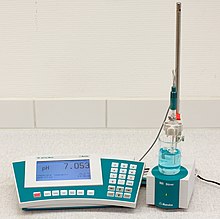pH meter

A pH meter , also known as a pH measuring chain , is a measuring device for determining and displaying the pH value of a solution. The value is to electrochemically determined paths and non- acid - base - indicators .
history
Between 1920 and 1940 the technical basis for pH measurement was created. So was z. B. In 1940 Jenaer Glas patented the pH meter based on hydrogen electrodes. The first pH meters with glass electrodes were developed in 1935 by Arnold Orville Beckman for measuring the citric acid concentration in citrus fruits and produced by the company he founded, National Technical Laboratories . Other systems such as the quinone electrode or the antimony electrode were also introduced during this period.
Structure of pH meters
pH measurement with glass electrodes
The most frequently used measuring principle uses the potential of a glass electrode , which is also known as a pH electrode . A half-cell reaction on the glass membrane creates an electrical potential there, which is directly dependent on the H + ion concentration. The potential difference to the reference electrode produces a voltage that largely linearly maps the pH value. In most cases, a silver-silver chloride half-cell is used as the reference electrode , which is combined with the glass electrode to form a so-called single-rod measuring chain. The reference electrode is connected to the solution to be measured via a diaphragm , which is usually made of glass sponge, ceramic or platinum sponge. When not in use, the glass electrode is stored in a potassium chloride solution in order to keep the diaphragm potential-neutral and conductive.
Hardly any resilient current can be generated during the measurement. Therefore the measuring device has to be constructed from an amplifier with a very high input resistance and a downstream voltage indicator. For calibration, both the zero point and the gain factor ( slope ) of the circuit must be adjustable. Because of the low resilience of the measurement potential, it is also very easy to disrupt the measurement, for example due to so-called streaming potentials. Contamination and leaching of the diaphragm also lead to measurement errors. Furthermore, a stable equilibrium measured value is established more slowly, the lower the buffer capacity of the material to be measured.
pH measurement with field effect transistors
A newer measuring principle is based on an ion-sensitive field effect transistor (ISFET). The measured values of the ISFET are somewhat more stable and the downstream electronics are more robust. For this, the service life (durability, number of possible measuring processes) of the sensor should be shorter. The measured values do not agree very well between the glass electrode and the ISFET, since the deviations from linearity and the accompanying measurement errors are different.
This illustrates the general problem of pH information. On the one hand, the pH value is theoretically defined: as the negative logarithm of the hydronium ion concentration. On the other hand, the measurement shows so many problems that the operational definition is often used: The pH value is the measured value displayed by a glass electrode pH meter with a measured object at rest at 20 ° C (plus further specifications of the calibration and measurement process). A widespread resistance from measurement practitioners to ISFET measurement is based on the awareness of the difficulties of pH determination and the tacit agreement on this operational definition.
pH measurement with hydrogen electrodes
Probably the oldest technology for pH measurement is based on the pH dependency of the hydrogen potential (see reversible hydrogen electrode ). Up to now, such pH meters have been technically complex - the hydrogen supply in particular requires a high level of technical effort. This has been remedied in recent years, so now the benefits
- no alkali error (see figure)
- no acid error
- mechanically stable
- very low impedance (input resistance)
with the disadvantages
- Sensitivity to oxidizing or reducing species
- Sensitivity to heavy metal salts that are nobler than hydrogen (Cu, Ag, Hg)
must be weighed. However, the disadvantages cited here are of a theoretical nature and must still be examined in detail.
adjustment
In order to obtain accurate measurement results, it is common practice to adjust pH meters at least once a day before use . For this purpose, buffer solutions with a known pH value are used as the calibration liquid . Usually at least two, better three, buffer solutions with pH values of 4.7 and 10 are used. These solutions are available ready-to-use from specialist laboratory retailers and are rarely prepared by yourself. The measured value displayed by the pH meter is adjusted accordingly, ie adapted to the pH value of the buffer solutions.
application areas
Today pH meters are used in a wide variety of areas, especially in industry , medicine , aquaristics and in swimming pools. It is therefore impossible to imagine everyday life without pH meters in order to ensure safety when using cosmetic products such as shampoo, cleaning agents or regular swimming pool visits. Too aggressive alkalis or acids could harm people and must therefore be constantly and precisely checked.
Web links
Individual evidence
- ↑ The Beckman pH Meter ( Memento of the original from September 28, 2011 in the Internet Archive ) Info: The archive link was inserted automatically and has not yet been checked. Please check the original and archive link according to the instructions and then remove this notice. , American Chemical Society , 2004, accessed August 16, 2010.
- ↑ Kurt Schwabe, Electrometric pH measurement under extreme conditions, Verlag Chemie, 1960, page 15
- ↑ Kathy Barker: The Cold Spring Harbor Laboratory Handbook for Beginners , Spektrum Akademischer Verlag, Heidelberg, 2006, pp. 139–144, ISBN 978-3-8274-1656-8 .
- ↑ pH meter: functionality and application ( Memento from February 4, 2013 in the Internet Archive ). Who delivers what? , 2013



